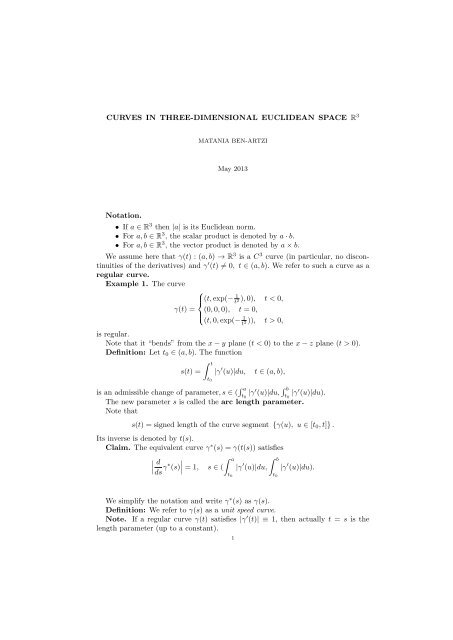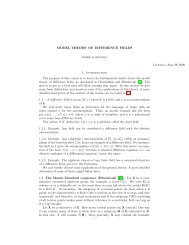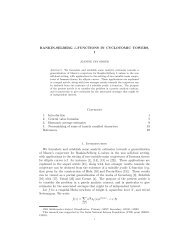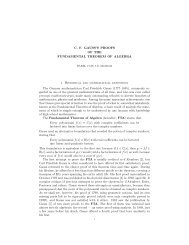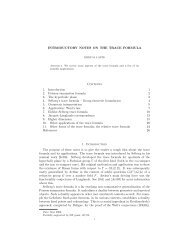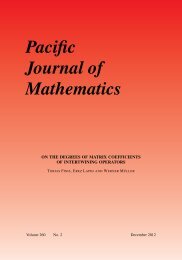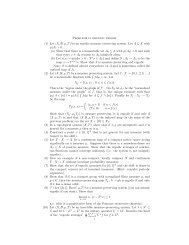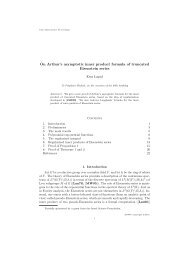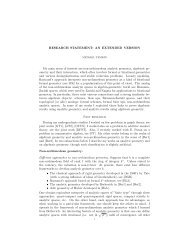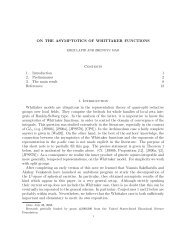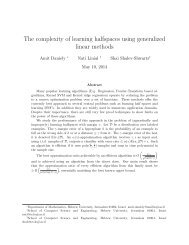CURVES IN THREE-DIMENSIONAL EUCLIDEAN SPACE R3 ...
CURVES IN THREE-DIMENSIONAL EUCLIDEAN SPACE R3 ...
CURVES IN THREE-DIMENSIONAL EUCLIDEAN SPACE R3 ...
- No tags were found...
Create successful ePaper yourself
Turn your PDF publications into a flip-book with our unique Google optimized e-Paper software.
<strong>CURVES</strong> <strong>IN</strong> <strong>THREE</strong>-<strong>DIMENSIONAL</strong> <strong>EUCLIDEAN</strong> <strong>SPACE</strong> R 3MATANIA BEN-ARTZIMay 2013Notation.• If a ∈ R 3 then |a| is its Euclidean norm.• For a, b ∈ R 3 , the scalar product is denoted by a · b.• For a, b ∈ R 3 , the vector product is denoted by a × b.We assume here that γ(t) : (a, b) → R 3 is a C 3 curve (in particular, no discontinuitiesof the derivatives) and γ ′ (t) ≠ 0, t ∈ (a, b). We refer to such a curve as aregular curve.Example 1. The curve⎧⎪⎨ (t, exp(− 1 t), 0), t < 0,2γ(t) = (0, 0, 0), t = 0,⎪⎩(t, 0, exp(− 1 t)), t > 0,2is regular.Note that it “bends” from the x − y plane (t < 0) to the x − z plane (t > 0).Definition: Let t 0 ∈ (a, b). The functions(t) =∫ tt 0|γ ′ (u)|du,t ∈ (a, b),is an admissible change of parameter, s ∈ ( ∫ at 0|γ ′ (u)|du, ∫ bt 0|γ ′ (u)|du).The new parameter s is called the arc length parameter.Note thats(t) = signed length of the curve segment {γ(u), u ∈ [t 0 , t]} .Its inverse is denoted by t(s).Claim. The equivalent curve γ ∗ (s) = γ(t(s)) satisfies∣ d ∫ a ∫ bds γ∗ (s) ∣ = 1, s ∈ ( |γ ′ (u)|du, |γ ′ (u)|du).t 0t 0We simplify the notation and write γ ∗ (s) as γ(s).Definition: We refer to γ(s) as a unit speed curve.Note. If a regular curve γ(t) satisfies |γ ′ (t)| ≡ 1, then actually t = s is thelength parameter (up to a constant).1
2 MATANIA BEN-ARTZIExample 2. The unit speed circular helix isγ(s) = (r cos(ωs), r sin(ωs), hωs), s ∈ R,where ω 2 = (r 2 + h 2 ) −1 .In what follows, curves are parametrized by arc length s, unless explicitly statedotherwise.***************************************************************The FRENET-SERRET System***************************************************************To simplify notation in what follows, we do not specify explicitly the domain ofthe parameter.Definition: Let γ(s) be a unit speed curve. ThenT (s) = γ ′ (s) is called the unit tangent vector along the curve.The function κ(s) = |T ′ (s)| is called the curvature along the curve.Claim 1. The curvature κ(s) ≡ 0 if and only if γ(s) is a (segment of a) straightline.Proof. A straight line is of the form γ(s) = αs + β, where α, β ∈ R 3 and |α| = 1.Thus T (s) = α = constant.Conversely, κ(s) ≡ 0 ⇒ T ′ (s) ≡ 0 ⇒ T (s) = constant = α, hence γ(s) =αs + β.□The following example complements this claim by giving a typical case wherethe curvature never vanishes.Example 3. Let γ(s) be a regular unit speed curve, and assume that it lies ona sphere |x − x 0 | = r. Then κ(s) ≠ 0 for all s.Indeed, the condition means that |γ(s) − x 0 | 2 ≡ r 2 , and by two successive differentiationsT (s) · (γ(s) − x 0 ) ≡ 0 ⇒ T ′ (s) · (γ(s) − x 0 ) + |T (s)| 2 = T ′ (s) · (γ(s) − x 0 ) + 1 ≡ 0.From now on we assume that κ(s) ≠ 0.We regard s → T (s) ∈ R 3 as a curve . Note that it lies on the unit sphere, buts is not the arc length parameter of this curve.Claim 2. Let δ(t) ⊆ R 3 be a smooth curve with δ(t)| ≡ 1. Then δ ′ (t) · δ(t) ≡ 0,namely, δ ′ (t) ⊥ δ(t) for all t.(Observe that here t is in general not the arc length parameter).Proof. Differentiate the equation δ(t) · δ(t) ≡ 0.Definition: The unit vector N(s) = κ(s) −1 T ′ (s) is called the normal alongthe curve.By Claim 2, N(s) ⊥ T (s) for all s.Definition: The unit vector B(s) = T (s) × N(s) is called the binormal alongthe curve.Definition: The orthonormal system T (s), N(s), B(s) is called The Frenet-Serret frame. It is clearly a basis for R 3 that varies along the curve, following the“twists” of the curve in space.Definition: The scalar function τ(s) = −B ′ (s) · N(s) is called the torsion ofthe curve.□
<strong>CURVES</strong> <strong>IN</strong> <strong>THREE</strong>-<strong>DIMENSIONAL</strong> <strong>EUCLIDEAN</strong> <strong>SPACE</strong> R 3 3Definition: The Frenet-Serret system T (s), N(s), B(s) combined with the twoscalar functions κ(s), τ(s), is called the Frenet-Serret apparatus of the curve.Theorem (The Frenet-Serret Equations). Given a regular unit speed curveγ(s), with κ(s) ≠ 0, the following equations are satisfied:T ′ (s) =κ(s)N(s),N ′ (s) = − κ(s)T (s) + τ(s)B(s),B ′ (s) = − τ(s)N(s).Proof. The first equation follows from the definition of N(s).For the second equation, note first that by Claim 2, N ′ (s) ⊥ N(s).For the other coefficients of N ′ (s) in the T, N, B system we have:and0 = d ds (T (s) · N(s)) = T ′ (s) · N(s) + T (s) · N ′ (s) = κ(s) + T (s) · N ′ (s),0 = d ds (B(s) · N(s)) = B′ (s) · N(s) + B(s) · N ′ (s) = −τ(s) + B(s) · N ′ (s).For the third equation, similarly,dds (T (s) · B(s)) = T ′ (s) · B(s) + T (s) · B ′ (s) = 0 + T (s) · B ′ (s),since T ′ (s) · B(s) = κ(s)N(s) · B(s) = 0.Finally, N(s) · B ′ (s) = −τ(s) by definition.□The geometric meaning of τ(s) is made clear by the following claim, whichcomplements Claim 1.Claim 3. Let γ(s) be a regular unit speed curve. Then the following threeconditions are equivalent:(1) It is a planar curve (namely, there exists a plane containing it).(2) B(s) ≡ B 0 , where B 0 ∈ R 3 is a constant vector.(3) τ(s) ≡ 0.Remark. Note that in view of Claim 1, if κ(s) ≡ 0, then the curve is a straightsegment, hence planar. Thus, we can assume κ(s) ≠ 0.Proof of Claim 3. • (1) ⇒ (2). In this case T (s), hence also N(s), are in thisplane so B(s) =(constant) unit normal to the plane, which is B 0 .• (2) ⇔ (3). Both directions follow from the third F-S equation.• (2) ⇒ (1). Both T (s), N(s) are in the plane P perpendicular to B 0 , andwe can assume it contains some point on the curve, say γ(0). Thenγ(s) − γ(0) =∫ s0T (τ)dτ ∈ P.The following claim asserts that the two scalar functions κ(s), τ(s), determinethe curve γ(s).□
4 MATANIA BEN-ARTZIClaim 4. Let γ 1 (s), γ 2 (s), s ∈ (l, L), be two regular curves with Frenet-Serretapparatus T 1 (s), N 1 (s), B 1 (s), κ 1 (s), τ 1 (s), and T 2 (s), N 2 (s), B 2 (s), κ 2 (s), τ 2 (s),respectively, and such that:•κ 1 (s) = κ 2 (s), τ 1 (s) = τ 2 (s), s ∈ (l, L),•γ 1 (s 0 ) = γ 2 (s 0 ), T 1 (s 0 ) = T 2 (s 0 ), N 1 (s 0 ) = N 2 (s 0 ) B 1 (s 0 ) = B 2 (s 0 )Then γ 1 (s) = γ 2 (s), s ∈ (l, L).Proof. Define a scalar functionfor some s 0 ∈ (l, L).f(s) = |T 1 (s) − T 2 (s)| 2 + |N 1 (s) − N 2 (s)| 2 + |B 1 (s) − B 2 (s)| 2 .Differentiating and using the F-S equations (note that curvatures and torsions areequal) it is easy to see thatdf(s) = 0, s ∈ (l, L).dsThus f(s) = const, and by assumption f(s 0 ) = 0, so f(s) ≡ 0.It follows that T 1 (s) ≡ T 2 (s), soγ 1 (s) = γ 1 (s 0 ) +∫ ss 0T 1 (ξ)dξ = γ 2 (s 0 ) +∫ ss 0T 2 (ξ)dξ = γ 2 (s).□Remark. The claim says that if two curves intersect at some point s 0 , andthey have there the same Frenet-Serret frame T (s 0 ), N(s 0 ), B(s 0 ), and if theircurvatures and torsions are identical (for all s), then they coincide.Note that if γ 1 (s), γ 2 (s), are two regular curves, then by rigid translation androtation we can “align” them at a given point, namely, they intersect at this pointand their Frenet-Serret systems are equal there. Such transformations do not changethe curvature and torsion (why?), so the claim can be rephrased:Claim 4’. The curvature and torsion of a curve determine it uniquely, up totranslation and rotation.Note. The question if, for a given pair of continuous functions κ(s), τ(s), thereexists a curve γ(s) so that these functions are, respectively, its curvature and torsion,is a question of existence of a solution to the linear system of the Frenet-Serretdifferential equations. The claim says that we can find at most one such curve.Institute of Mathematics, Hebrew University, Jerusalem 91904, IsraelE-mail address: mbartzi@math.huji.ac.il


